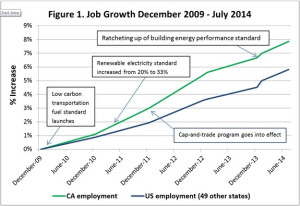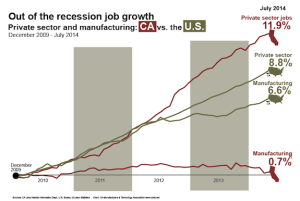This week, Chris Busch, the Director of Research at Energy Innovation: Policy and Technology LLC wrote a piece that appeared in both LiveScience and CaliforniaCarbon.info. Essentially the piece praised California’s bold energy policies and claimed that our state’s economy is flourishing because of them. Of specific note was a chart that showed our employment growth and timelined a few of California’s energy requirements. Those policies include the Low Carbon Fuel Standard, the 33 percent renewable power mandate, the state’s carbon cap-and-trade system, and building energy performance standards.
The chart compared California’s total employment growth since December 2009 to that of the United States. In aggregate numbers we are in fact outpacing the country. But what types of jobs are we growing? We know from research we did a few weeks ago that most of our growth is coming from sectors that pay less. This week we charted the same dates and numbers as Mr. Busch but added a percentage growth for California’s manufacturing job growth vs. the U.S.
The results show a large deficiency in manufacturing in California. At an average $77,000 salary and tremendous ripple effects in the economy, can we afford to ignore such a deficiency? What state revenues are we losing out on by not keeping pace with national manufacturing growth? California’s energy policies drive some of the highest industrial electricity rates in the country. Those costs will discourage manufacturers from choosing to invest in California, especially those looking to invest, re-shore, or scale up somewhere in the U.S.
Before concluding that California energy policies do not hurt jobs, we suggest that Mr. Busch and others account for the quality, as well as the quantity, of jobs we are losing and gaining in the state.
Chris Busch’s chart
 CMTA’s chart with manufacturing:
CMTA’s chart with manufacturing:
* We used the same data source as Mr. Busch but we didn’t include government in our total employment numbers, which might be why our percentages for “private sector” jobs are higher than their “total employment”.


